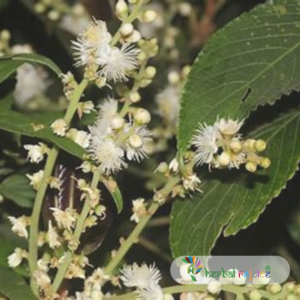Introduction
Symplocos racemosa, also known as lodh tree or sapphire berry, is a powerful medicinal plant native to North and eastern India, with its range extending southwards to Peninsular India. This article will explore the various medicinal properties and uses of Symplocos racemosa, as well as its scientific counterparts.
The English names for Symplocos racemosa are lodh tree and sapphire berry, while it is known as Lodhra, Rodhra, Shaavara, Sthulavalkal, Trita, Pattikaa Lodhra, and Shaabara Lodhra in Ayurvedic medicine. In Unani medicine, it is called Lodh Pathaani, and in Siddha/Tamil medicine, it is referred to as Vellilethi and Vellilothram.
Medicinal Uses
One of the primary uses of the bark of Symplocos racemosa is as a specific remedy for uterine complaints, vaginal diseases, and menstrual disorders. It has been traditionally employed for treating conditions like menorrhagia and leucorrhoea (as mentioned in The Ayurvedic Pharmacopoeia of India). Additionally, the bark has been used to alleviate diarrhoea, dysentery, vaginal ulcers, inflammatory affections, and liver disorders.

Chemical Constituents
Scientific studies have identified several active compounds present in the bark of Symplocos racemosa, including colloturine, harman (loturine), and loturidine. Proanthocyanidin-3-monoglucofuranosides of 7-O-methyl-and 4’-Omethyl-leucopelargonidin have also been isolated from the stem bark. Other compounds found in the plant include betulinic acid, oleanolic acid, acetyl oleanolic acid, and ellagic acid. Glycosides extracted from the ethanolic extract of the stem bark possess strong astringent properties and are responsible for the medicinal benefits of the bark.
Impact on Uterine Contractions
Furthermore, studies have shown that the bark extracts of Symplocos racemosa can reduce the frequency and intensity of uterine contractions in both pregnant and non-pregnant animal models. Additional research has demonstrated that a specific fraction from the bark exhibits spasmogenic activity on various parts of the gastrointestinal tract, which can be counteracted by atropine. Furthermore, the bark extracts have been found to inhibit the growth of E. coli, Micrococcus pyogenes var. aureus, and enteric and dysenteric groups of organisms.
Dosage
When using Symplocos racemosa, the recommended dosage for the stem bark is 3-5 grams of powder or 20-30 grams for decoction, as specified in The Ayurvedic Pharmacopoeia of India (API).
Hypoglycemic Effects in Animal Studies
In addition to Symplocos racemosa, other species within the Symplocos genus have also been utilized in folk medicine. For instance, Symplocos theaefolia, found in the Eastern Himalayas and the Khasi Hills, is known as Kharanl in Nepal and Dieng-pei or Dieng-twe-pe in Khasi. The ethanolic extract of the leaves of Symplocos theaefolia has demonstrated hypoglycemic activity in rats and anticancer activity against Friendvirus-leukemia (solid) in mice. Furthermore, extracts from the leaves and stems have shown activity against human epidermoid carcinoma of the nasopharynx in tissue-culture.
It’s important to note that Symplocos phyllocalyx C. B. Clarke, also known as chandan and laal-chandan, should not be confused with Santalum album or Pterocarpus santalinus.
Conclusion
In conclusion, Symplocos racemosa (lodh tree) has a long-standing history of being used in traditional medicine to address various uterine complaints, vaginal diseases, and gastrointestinal disorders. Through scientific research, its therapeutic properties have been validated, making it worth considering as a natural remedy for these ailments.
Frequently Asked Questions
What is Symplocos racemosa?
Symplocos racemosa, also known as lodh tree or sapphire berry, is a medicinal plant native to North and eastern India with a range extending to Peninsular India.
What are the English names for Symplocos racemosa?
The English names for Symplocos racemosa are lodh tree and sapphire berry.
What are the Ayurvedic names for Symplocos racemosa?
In Ayurvedic medicine, Symplocos racemosa is known as Lodhra, Rodhra, Shaavara, Sthulavalkal, Trita, Pattikaa Lodhra, and Shaabara Lodhra.
What is Symplocos racemosa called in Unani medicine?
In Unani medicine, Symplocos racemosa is called Lodh Pathaani.
What is Symplocos racemosa called in Siddha/Tamil medicine?
In Siddha/Tamil medicine, Symplocos racemosa is referred to as Vellilethi and Vellilothram.
What are some traditional uses of Symplocos racemosa?
The bark of Symplocos racemosa has been traditionally used to treat uterine complaints, vaginal diseases, menstrual disorders, diarrhoea, dysentery, vaginal ulcers, inflammatory affections, and liver disorders.
What active compounds are found in the bark of Symplocos racemosa?
The bark of Symplocos racemosa contains compounds such as colloturine, harman (loturine), loturidine, proanthocyanidin-3-monoglucofuranosides of 7-O-methyl- and 4’-Omethyl-leucopelargonidin, betulinic acid, oleanolic acid, acetyl oleanolic acid, and ellagic acid.
What are the medicinal benefits of Symplocos racemosa?
The bark extracts of Symplocos racemosa have astringent properties and can help alleviate uterine complaints, vaginal diseases, and gastrointestinal disorders. They also inhibit the growth of certain bacteria.
Can Symplocos racemosa help with uterine contractions?
Yes, studies have shown that the bark extracts of Symplocos racemosa can reduce the frequency and intensity of uterine contractions in both pregnant and non-pregnant animals.
How should Symplocos racemosa be taken?
The recommended dosage for the stem bark of Symplocos racemosa is 3-5 grams of powder or 20-30 grams for decoction.
Are there other species within the Symplocos genus with medicinal uses?
Yes, other species within the Symplocos genus, such as Symplocos theaefolia, have been used in folk medicine for various purposes.
What is the medicinal activity of Symplocos theaefolia?
The ethanolic extract of the leaves of Symplocos theaefolia has demonstrated hypoglycemic activity and anticancer activity against Friendvirus-leukemia in mice.
What is important to know about Symplocos phyllocalyx C. B. Clarke?
Symplocos phyllocalyx C. B. Clarke, also known as chandan and laal-chandan, should not be confused with Santalum album or Pterocarpus santalinus.
Can Symplocos racemosa be used as a natural remedy for uterine complaints?
Yes, the therapeutic properties of Symplocos racemosa have been validated through scientific research, making it a potential natural remedy for uterine complaints.
Can Symplocos racemosa be used to treat vaginal diseases?
Yes, Symplocos racemosa has traditionally been used to treat vaginal diseases like leucorrhoea.
Can Symplocos racemosa help with menstrual disorders?
Yes, Symplocos racemosa has been traditionally employed for treating menstrual disorders such as menorrhagia.


